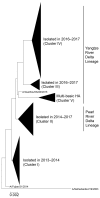Characterization of Mouse Monoclonal Antibodies Against the HA of A(H7N9) Influenza Virus
- PMID: 30754701
- PMCID: PMC6410113
- DOI: 10.3390/v11020149
Characterization of Mouse Monoclonal Antibodies Against the HA of A(H7N9) Influenza Virus
Abstract
Many cases of human infection with the H7N9 virus have been detected in China since 2013. H7N9 viruses are maintained in chickens and are transmitted to humans at live bird markets. During circulation in birds, H7N9 viruses have accumulated amino acid substitutions in their hemagglutinin (HA), which resulted in an antigenically change in the recent H7N9 viruses. Here, we characterized 46 mouse monoclonal antibodies against the HA of the prototype strain. 16 H7-HA-specific monoclonal antibodies (mAbs) possessed hemagglutination inhibition (HI) and neutralization activities by recognizing the major antigenic site A; four other H7-HA-specific clones also showed HI and neutralizing activities via recognition of the major antigenic sites A and D; seven mAbs that reacted with several HA subtypes and possibly recognized the HA stem partially protected mice from lethal infection with prototype H7N9 virus; and the remaining 19 mAbs had neither HI nor neutralization activity. All human H7N9 viruses tested showed a similar neutralization sensitivity to the first group of 16 mAbs, whereas human H7N9 viruses isolated in 2016‒2017 were not neutralized by a second group of 4 mAbs. These results suggest that amino acid substitutions at the epitope of the second mAb group appear to be involved in the antigenic drift of the H7N9 viruses. Further analysis is required to fully understand the antigenic change in H7N9 viruses.
Keywords: Antigenic change; H7N9; HA; Influenza A virus; Neutralization; mouse monoclonal antibody.
Conflict of interest statement
Y.K. has received speaker’s honoraria from Toyama Chemical and Astellas Inc., has received grant support from Chugai Pharmaceuticals, Daiichi Sankyo Pharmaceutical, Toyama Chemical, Tauns Laboratories, Inc., Otsuka Pharmaceutical Co., Ltd., and Denka Seiken Co., Ltd., and is a co-founder of FluGen. K.M., K.S., A.M., and K.N. are employees of TAUNS Laboratories, Inc. The other authors have no conflicts of interest to declare.
Figures



Similar articles
-
A cross-reactive human monoclonal antibody targets the conserved H7 antigenic site A from fifth wave H7N9-infected humans.Antiviral Res. 2019 Oct;170:104556. doi: 10.1016/j.antiviral.2019.104556. Epub 2019 Jul 9. Antiviral Res. 2019. PMID: 31299269
-
L226Q Mutation on Influenza H7N9 Virus Hemagglutinin Increases Receptor-Binding Avidity and Leads to Biased Antigenicity Evaluation.J Virol. 2020 Sep 29;94(20):e00667-20. doi: 10.1128/JVI.00667-20. Print 2020 Sep 29. J Virol. 2020. PMID: 32796071 Free PMC article.
-
Inactivated H7 Influenza Virus Vaccines Protect Mice despite Inducing Only Low Levels of Neutralizing Antibodies.J Virol. 2017 Sep 27;91(20):e01202-17. doi: 10.1128/JVI.01202-17. Print 2017 Oct 15. J Virol. 2017. PMID: 28768855 Free PMC article.
-
Cross-reactive mouse monoclonal antibodies raised against the hemagglutinin of A/Shanghai/1/2013 (H7N9) protect against novel H7 virus isolates in the mouse model.Emerg Microbes Infect. 2018 Jun 20;7(1):110. doi: 10.1038/s41426-018-0115-0. Emerg Microbes Infect. 2018. PMID: 29925896 Free PMC article.
-
New antibody-based prevention and treatment options for influenza.Antiviral Res. 2019 Oct;170:104562. doi: 10.1016/j.antiviral.2019.104562. Epub 2019 Jul 16. Antiviral Res. 2019. PMID: 31323236 Review.
Cited by
-
Influenza Virus Like Particles (VLPs): Opportunities for H7N9 Vaccine Development.Viruses. 2020 May 8;12(5):518. doi: 10.3390/v12050518. Viruses. 2020. PMID: 32397182 Free PMC article. Review.
-
Epitopes in the HA and NA of H5 and H7 avian influenza viruses that are important for antigenic drift.FEMS Microbiol Rev. 2024 May 8;48(3):fuae014. doi: 10.1093/femsre/fuae014. FEMS Microbiol Rev. 2024. PMID: 38734891 Free PMC article. Review.
-
Quantum dot immunochromatographic strip for rapid and sensitive detection of H5 subtype avian influenza virus.Virol J. 2025 Jul 18;22(1):246. doi: 10.1186/s12985-025-02882-9. Virol J. 2025. PMID: 40682134 Free PMC article.
-
Production and identification of monoclonal antibodies and development of a sandwich ELISA for detection of the H3-subtype avian influenza virus antigen.AMB Express. 2020 Mar 14;10(1):49. doi: 10.1186/s13568-020-00988-7. AMB Express. 2020. PMID: 32170425 Free PMC article.
-
Generation of neutralizing and non-neutralizing monoclonal antibodies against H7N9 influenza virus.Emerg Microbes Infect. 2020 Mar 20;9(1):664-675. doi: 10.1080/22221751.2020.1742076. eCollection 2020. Emerg Microbes Infect. 2020. PMID: 32193996 Free PMC article.
References
-
- Chen Y., Liang W., Yang S., Wu N., Gao H., Sheng J., Yao H., Wo J., Fang Q., Cui D., et al. Human infections with the emerging avian influenza A H7N9 virus from wet market poultry: Clinical analysis and characterisation of viral genome. Lancet. 2013;381:1916–1925. doi: 10.1016/S0140-6736(13)60903-4. - DOI - PMC - PubMed
Publication types
MeSH terms
Substances
LinkOut - more resources
Full Text Sources
Medical

